旅游专业英语教案12Task 5 Discussing the itinerary (part two)
- 格式:doc
- 大小:70.50 KB
- 文档页数:6
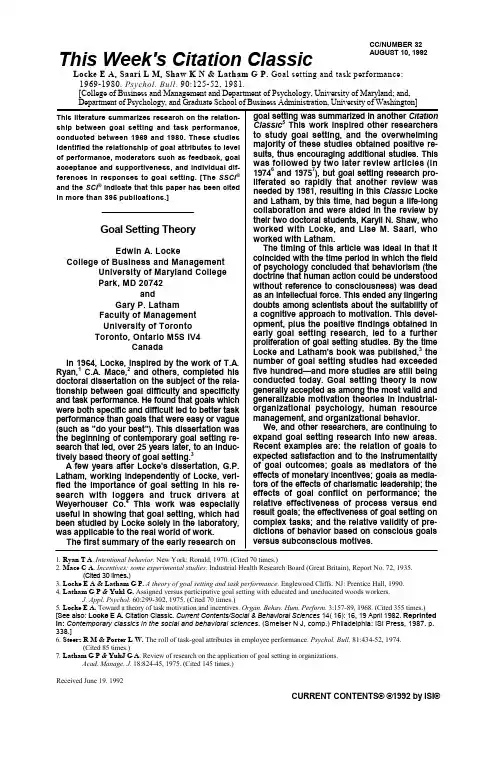
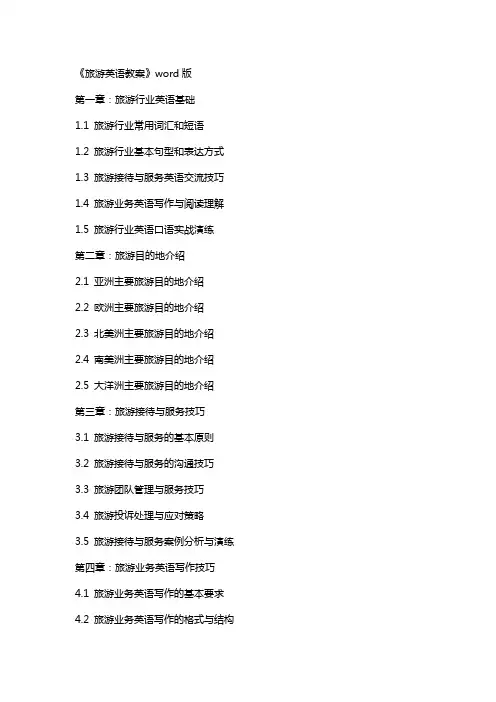
《旅游英语教案》word版第一章:旅游行业英语基础1.1 旅游行业常用词汇和短语1.2 旅游行业基本句型和表达方式1.3 旅游接待与服务英语交流技巧1.4 旅游业务英语写作与阅读理解1.5 旅游行业英语口语实战演练第二章:旅游目的地介绍2.1 亚洲主要旅游目的地介绍2.2 欧洲主要旅游目的地介绍2.3 北美洲主要旅游目的地介绍2.4 南美洲主要旅游目的地介绍2.5 大洋洲主要旅游目的地介绍第三章:旅游接待与服务技巧3.1 旅游接待与服务的基本原则3.2 旅游接待与服务的沟通技巧3.3 旅游团队管理与服务技巧3.4 旅游投诉处理与应对策略3.5 旅游接待与服务案例分析与演练第四章:旅游业务英语写作技巧4.1 旅游业务英语写作的基本要求4.2 旅游业务英语写作的格式与结构4.3 旅游业务英语写作的常用句型与表达方式4.4 旅游业务英语写作的实战演练4.5 旅游业务英语写作的修改与评价第五章:旅游英语口语实战演练5.1 旅游接待与服务口语交流技巧5.2 旅游导游与讲解口语交流技巧5.3 旅游购物与餐饮口语交流技巧5.4 旅游安全事故处理与应对口语交流技巧5.5 旅游英语口语实战演练案例分析与点评第六章:旅游英语听力理解6.1 旅游英语听力基本技巧6.2 旅游英语听力常用场景与对话6.3 旅游英语听力理解练习6.4 旅游英语听力材料实战演练6.5 旅游英语听力理解评估与反馈第七章:旅游英语阅读理解7.1 旅游英语阅读基本技巧7.2 旅游英语阅读常用体裁与特点7.3 旅游英语阅读理解练习7.4 旅游英语阅读材料实战演练7.5 旅游英语阅读理解评估与反馈第八章:旅游英语翻译技巧8.1 旅游英语翻译基本原则8.2 旅游英语翻译技巧与方法8.3 旅游英语翻译练习8.4 旅游英语翻译材料实战演练8.5 旅游英语翻译评估与反馈第九章:旅游英语商务交流9.1 旅游商务英语通信与邮件写作9.2 旅游商务英语会议与谈判技巧9.3 旅游商务英语报价与合同签订9.4 旅游商务英语营销与推广策略9.5 旅游英语商务交流案例分析与实战演练第十章:旅游英语教学评估与反馈10.1 旅游英语教学评估的目的与方法10.2 旅游英语教学反馈的技巧与方式10.3 旅游英语教学评估表设计与使用10.4 旅游英语教学问题分析与解决策略10.5 旅游英语教学评估与反馈案例分析与点评重点和难点解析重点和难点解析一:旅游行业英语基础重点:掌握旅游行业常用词汇和短语,理解旅游行业基本句型和表达方式。

![旅游专业英语(第四版)第一章教案 (2)[4页]](https://uimg.taocdn.com/3edb275526284b73f242336c1eb91a37f011324b.webp)
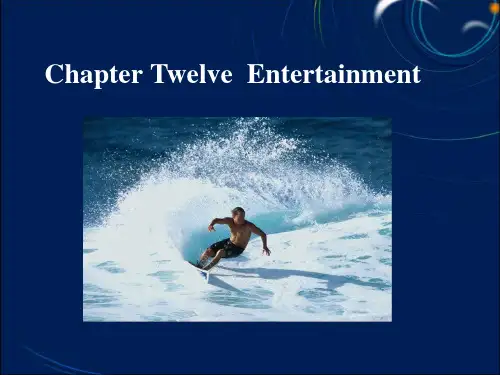
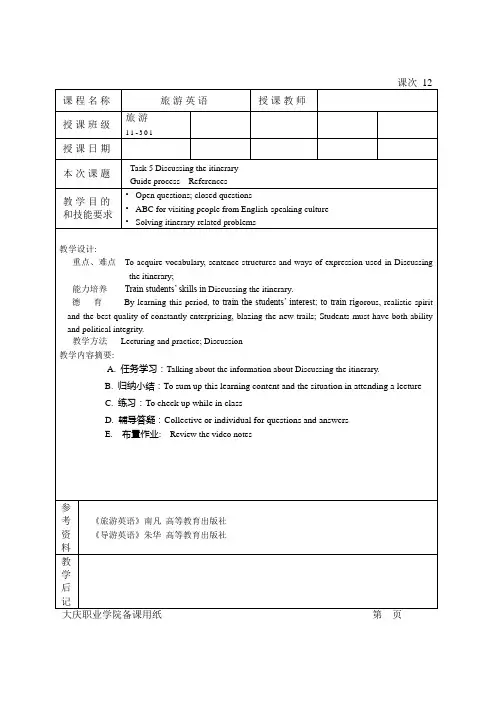
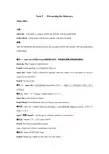
Task 5 Discussing the ItineraryMain video:人物:Janet Jin – local guide, is going to discuss the itinerary with the group leaderDaniel Black– group leader, will discuss itinerary with the local guide场景:Janet has helped the tour group check in, she is going to discuss the itinerary with the group leader, Daniel Black镜头一:Janet Jin正在往Daniel的房间打电话,和他约定商谈日程安排的事宜。
Janet Jin: May I speak to Daniel please?Daniel: Daniel speaking. Can I help you? Miss Jin.Janet Jin: I think I need to discuss the itinerary with you, Daniel. Is it convenient for you if I come to your room now?Daniel: Yes, that’s fine.镜头二:Janet Jin在用食指轻敲Daniel Black.的房门,每敲三下,她都会停下来听一听门内的反应。
镜头三:随着一声“Coming!” Daniel Black打开了门。
Janet Jin: Good afternoon, Daniel.Daniel Black: Good afternoon, Miss Jin. Please come and sit down.镜头四:Janet进门, Daniel Black把门轻轻掩上,Janet跟随Mr. Black走入房间,在桌子旁的椅子上坐下。
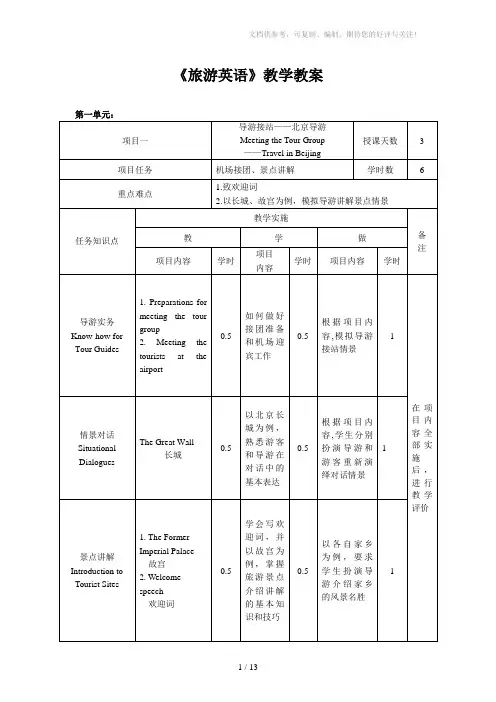
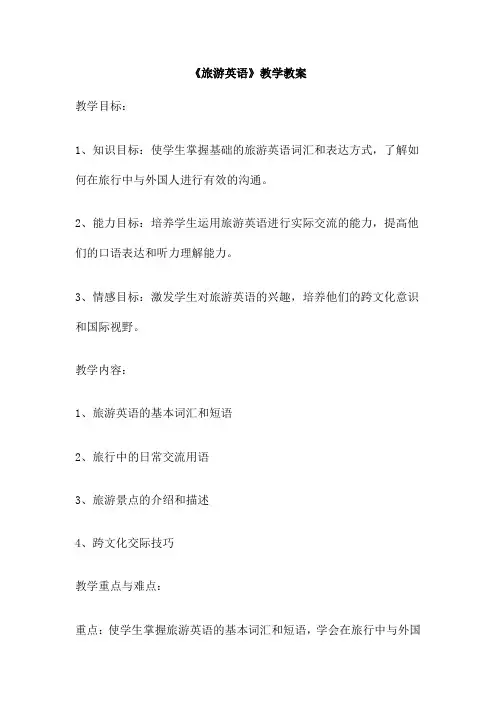
《旅游英语》教学教案教学目标:1、知识目标:使学生掌握基础的旅游英语词汇和表达方式,了解如何在旅行中与外国人进行有效的沟通。
2、能力目标:培养学生运用旅游英语进行实际交流的能力,提高他们的口语表达和听力理解能力。
3、情感目标:激发学生对旅游英语的兴趣,培养他们的跨文化意识和国际视野。
教学内容:1、旅游英语的基本词汇和短语2、旅行中的日常交流用语3、旅游景点的介绍和描述4、跨文化交际技巧教学重点与难点:重点:使学生掌握旅游英语的基本词汇和短语,学会在旅行中与外国人进行日常交流。
难点:如何准确、流利地使用旅游英语进行交流,以及跨文化交际技巧的应用。
教具和多媒体资源:1、投影仪和PPT2、旅游英语视频材料3、旅游英语词汇卡片4、模拟场景道具教学方法:1、激活学生的前知:回顾已学的英语词汇和短语,与旅游英语相关的内容进行对比和。
2、教学策略:通过讲解、示范、小组讨论和角色扮演等方式,使学生掌握旅游英语的表达方式。
3、学生活动:组织学生进行模拟旅行对话,提高他们的口语表达和听力理解能力。
教学过程:1、导入(5分钟):通过提问的方式,了解学生对旅游英语的兴趣和前期知识储备。
2、讲授新课(30分钟):讲解旅游英语的基本词汇和短语,展示并让学生模仿实用的旅行对话。
3、巩固练习(15分钟):学生分组进行角色扮演,模拟旅行中的各种场景进行对话。
教师进行巡视,给予必要的指导和反馈。
4、归纳小结(10分钟):总结本节课学习的重点内容,回顾旅行英语的关键表达方式,鼓励学生进行口头总结。
评价与反馈:1、设计评价策略:组织学生进行小组角色扮演活动,观察他们的实际交流能力和口语表达水平。
结合学生的自我评价和互相评价,对学生的学习效果进行综合评估。
2、为学生提供反馈:在角色扮演活动结束后,对学生的表现给予及时的反馈,指出他们在旅游英语表达中的优点和不足之处。
引导学生反思自己的学习过程和方法,以便进一步提高学习效果。
作业布置:1、复习本节课所学的旅游英语词汇和短语。
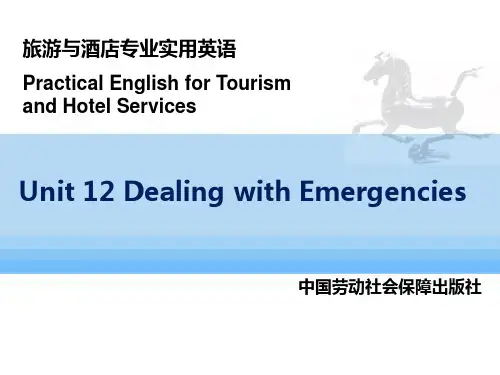
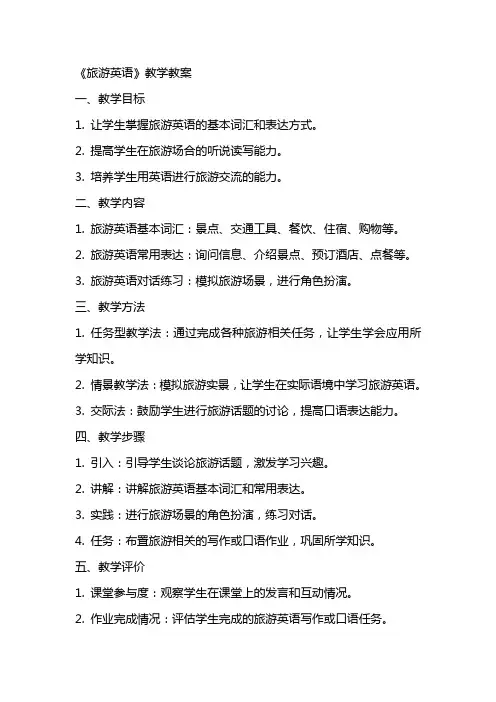
《旅游英语》教学教案一、教学目标1. 让学生掌握旅游英语的基本词汇和表达方式。
2. 提高学生在旅游场合的听说读写能力。
3. 培养学生用英语进行旅游交流的能力。
二、教学内容1. 旅游英语基本词汇:景点、交通工具、餐饮、住宿、购物等。
2. 旅游英语常用表达:询问信息、介绍景点、预订酒店、点餐等。
3. 旅游英语对话练习:模拟旅游场景,进行角色扮演。
三、教学方法1. 任务型教学法:通过完成各种旅游相关任务,让学生学会应用所学知识。
2. 情景教学法:模拟旅游实景,让学生在实际语境中学习旅游英语。
3. 交际法:鼓励学生进行旅游话题的讨论,提高口语表达能力。
四、教学步骤1. 引入:引导学生谈论旅游话题,激发学习兴趣。
2. 讲解:讲解旅游英语基本词汇和常用表达。
3. 实践:进行旅游场景的角色扮演,练习对话。
4. 任务:布置旅游相关的写作或口语作业,巩固所学知识。
五、教学评价1. 课堂参与度:观察学生在课堂上的发言和互动情况。
2. 作业完成情况:评估学生完成的旅游英语写作或口语任务。
3. 期末考试:测试学生旅游英语的综合运用能力。
六、教学资源1. 教材:《旅游英语》教材或相关旅游英语学习资料。
2. 多媒体课件:旅游景点图片、视频、音频等。
3. 角色扮演道具:地图、飞机票、酒店卡片等。
4. 在线资源:旅游英语学习网站、旅游资讯网站等。
七、教学环境1. 教室布局:座位排列便于学生互动交流。
2. 教学设备:投影仪、音响、计算机等。
3. 氛围营造:轻松愉快的旅游主题氛围,如播放旅游相关音乐。
八、教学策略1. 差异化教学:针对不同水平的学生,提供相应难度的旅游英语学习材料。
2. 激励机制:设置旅游主题的奖励,鼓励学生积极参与。
3. 合作学习:组织学生进行小组讨论,共同完成旅游英语任务。
九、教学计划1. 课时安排:每课时45分钟,共15课时。
2. 课程进度:按照教学大纲和教材安排课程内容。
3. 作业布置:每节课后布置相关旅游英语作业,巩固所学知识。
旅游专业英语教案五篇第一篇:旅游专业英语教案旅游专业英语电子教案UnitOne A.ObjectivesStudents will be able to: 1)Be familiar with the expressions of itinerary;2)Describe a scenic spot;3)Learn how to write a tour itinerary and make a dialogue about tour.B.Important and difficult points1)Speaking skills: make a dialogue about itinerary.2)Comprehensive skills: Understand the passage in the text and on this basis, learn to describe content of the text, and discuss about the issue.3)Functions:Focus 1: how to write an itinerary;Focus 2: how to make a dialogue about tour;C.teaching contents and time allotment: 1st-2nd period: warming up and background information, comprehensive reading of Part A, explain new words, and phrases and expressions.Learn to write a tour itinerary.3rd-4th period: talk about package tour, understand passage of reading B and the structure of reading B, and discuss, explain new words, phrases and expressions.5th--6th period: Do the listening.Check the answers of excises on page 5-6.Make a dialogue about tour.D.Teaching Procedures Six teaching periods are needed to cover the whole unit, among which students will have a series of reading, listening, speaking and writing activities related to the theme of the unit.1.Period One and Period Two:⌝ Step one: warming up.Introduce some places in America.⌝Step two: let students do the fast reading to find out the route of the tour to America.⌝ Step three: do the global reading and thenanswer the questions on Task 1.⌝Step four: intensive reading.Explain the important words, phrases, expressions and sentences with some examples.⌝ Step five: read the sample of an itinerary on page6, learn how to write a tour itinerary.2.Period three and Period four:⌝ Step one: warming up.Talk about tours in summer vacation ⌝Step two: skimming reading and find the answers for the questions on Task2.⌝ Step three: read the passage again to grasp the main idea of each paragraph.⌝ Step four: intensive reading, understanding the important words, phrases, expressions and sentences with some examples.旅游专业英语电子教案3.Period five and Period six:⌝Step one: Do the listening.⌝Step two: make a dialogue about tour itinerary.⌝ Step three: make a dialogue based on Task 2.E.Homework 1st-2nd period: write a tour itinerary 3rd-4th period: finish the excises on page 5-6 5th--6th period: Finish Home Reading on page11.Notes: ⌝Important words: scenic;foothill;giant;fertile;raise;claim;prearrange, offer, comprise, relatively, afford, and so on.⌝Phrases: save from;on an inlet;a number of, a combination of, a variety of, prefer to, in advance, and cater to.⌝ Grammar: attributive clause;future progressive;⌝Difficult sentences:a)Where the Willamette flows into the Colunbia River, one of the great rivers of America, we will find Oregon’s largest city, Portland, known as the “City of Roses.”b)A package tour is a combination of several travel components provided by different suppliers, which are sold to the consumer as a single product at a single price.c)Besides, it is often easier to get into a special event as a member of a tour than as an individual since the tour operators have theexperience to know which attractions are worth a special trip.d)While the majority of tourists nowadays prefer to travel in groups with their entertainment and sightseeing included in the package, some tourists prefer personalized tours which provide the comfort of a guide to show them around scenic sights and make all the necessary arrangements for them.旅游专业英语电子教案UnitTwo A.ObjectivesStudents will be able to:1)Be familiar with elements of a short welcome speech and the expressions of hotel services.2)Discuss hotel services in simple words.3)Know how to write a short welcome speech.B.Important and difficult points1)Speaking skills: make a short welcome speech by group-work.2)Comprehensive skills: Understand the passage in the text and on this basis, learn to describe content of the text, and discuss about the issue.3)Functions:Focus 1: how to write a welcome speech;Focus 2: how to make dialogues about meeting tourists and hotel check-in;C.teaching contents and time allotment:1st-2nd period: warming up and background information, and figure out the main parts of a welcome speech.Intensive reading of Text A, explain new words, and phrases and expressions.3rd-4th period: understand text B, discuss, and explain new words, phrases and expressions.5th--6th period: Doing listening on page20.Learn to write a welcome speech.D.Teaching Procedures Six teaching periods are needed to cover the whole unit, among which students will have a series of reading, listening, speaking and writing activities related to thetheme of the unit.1.Period One and Period Two:⌝ Step one: help students review the important words and phrases in Unit 1.⌝Step two: talk about the elements of a welcome speech.⌝ Step three: skimming reading on text A and find the answers for the questions on Task 1.⌝Step three: intensive reading.Explain the important words, phrases, expressions and sentences with some examples.Period three and Period four:⌝ Step one: skimming reading on text B and find the answers for the questions on Task 2.⌝ Step two: intensive reading.Explain the important words, phrases, expressions and sentences with some examples.3.Period five and Period six:⌝ Step one: do listening on page20.3旅游专业英语电子教案⌝ Step two: check the answers of the excises on Page 17-18 ⌝ Step three: read the sample on Page 18 and learn to write a welcome speech.E.Homework 1st-2nd period: preview text B 3rd-4th period: Finish the exercise on page17-18.5th--6th period: write a welcome speechNotes:1)Important words: reset;suppose, establish, reset, encompass, cater;transient;resort;budget;prime and so on.2)Phrases: on behalf of;for most of;the first trip to;be considered as;date back;be set to;up to;allow sb to do sth;.3)Difficult sentences:a)Chinese culture is considered as one of the oldest civilizations, while the PRC is among the youngest nations of the world..b)The history of Chinese culture and China dates back to over 5,000 years ago, while the People’s Republic of China was established on October 1st, 1949.c)Although China encompassesenough territoryto include five different time zones, all of the clocks and watches in this nation are set to Beijing standard time, except XinJiang.d)After the beginning of the economic reform in 1978, we are making progress towards modernization, and we are having some free time and money to tour, not in China but also abroad.旅游专业英语电子教案UnitThree A.ObjectivesStudents will be able to: ⌝ grasp the main idea and structure of the text;⌝ Be familiar with the expressions of food service.⌝Discuss about Chinese food in simple words.⌝ Write a banquet menu and make a dialogue about restaurant conversation.B.Important and difficult points1)Speaking skills: make a dialogue about restaurant conversation.2)Comprehensive skills: Understand the passage in the text and on this basis, learn to describe content of the text, and discuss about the issue.3)Functions:Focus 1: how to write a banquet menu;Focus 2: how to make a dialogue about restaurant conversation;C.teaching contents and time allotment:1st-2nd period: warming up and background information, do the reading of Text A, explain new words, and phrases and expressions.3rd-4th period: understand the reading passage in Text B, learn to describe the main idea of each paragraph, and discuss, explain new words, phrases and expressions.5th--6th period: Do the listening.Learn to write a menu.D.Teaching Procedures Six teaching periods are needed to cover the whole unit, among which students will have a series of reading, listening, speaking and writing activities related to the theme of theunit.1.Period One and Period Two:⌝Step one: warming up.Ask students to talk about the specialties in their hometown.⌝ Step two: do the global reading and then answer the questions on Task 1.⌝ Step three: intensive reading.Explain the important words, phrases, expressions and sentences with some examples.2.Period three and Period four: ⌝Step one: warming up.Discuss the art of cooking.(technique, elements, seasonings and etc.)⌝Step two: skimming reading on text B and find the answers for the questions on Task2.⌝ Step three: read the passage again to grasp the main idea of each paragraph.5旅游专业英语电子教案⌝ Step four: intensive reading, understanding the important words, phrases, expressions and sentences with some examples.3.Period five and Period six:⌝ Step one: Do the listening.⌝ Step two: read the sample of a banquet menu on Page 31, learn to write menu.⌝ Step three: make a dialogue based on Task 1.E.Homework 1st-2nd period: preview text B 3rd-4th period: Finish the excises on Page30-31 5th--6th period: write a banquet menu.Notes:1)Important words: aroma;specialize;delicate;flavor;crave;distinctive;ensure and so on.2)Phrases: give rise to;appeal to;make use of;allow for;boast of;a variety of;see to it that;3)Difficult sentences:a)Quite different from Western cooking where recipes are followed strictly like laboratory instructions, Chinese cooking always allows for a creative and stylistic touch to it.b)Great attention is paid to aesthetic appreciation of the food because the food should be good not only in flavor and smell, but also incolor and appearance.UnitFour 6旅游专业英语电子教案A.ObjectivesStudents will be able to: ⌝ grasp the main idea and structure of the text;⌝ be familiar with the introduction of urban tourism.⌝translate text B.B.Important and difficult points1)Speaking skills: translate the text B.2)Comprehensive skills: Understand the passage in the text and on this basis, learn to describe content of the text, and discuss about the issue.3)Functions:Focus 1: how to write publicity for a tourist city;Focus 2: how to make a dialogue about Urban Tourism;C.teaching contents and time allotment:1st-2nd period: warming up and background information, do the reading of Text A, explain new words, and phrases and expressions.3rd-4th period: understand the reading passage in Text B, learn to describe the main idea of each paragraph, and discuss, explain new words, phrases and expressions.5th--6th period: Do the listening.D.Teaching Procedures Six teaching periods are needed to cover the whole unit, among which students will have a series of reading, listening, speaking and writing activities related to the theme of the unit.1.Period One and Period Two:⌝Step one: warming up.Ask students to talk about their experience of traveling ⌝Step two: do the global reading and then answer the questions on Task 1.⌝Step three: intensive reading.Explain the important words, phrases, expressions and sentences with some examples.2.Period three and Period four: ⌝ Step one: warming up.⌝ Step two: skimming reading ontext B and find the answers for the questions on Task2.⌝Step three: read the passage again to grasp the main idea of each paragraph.⌝Step four: intensive reading, understanding the important words, phrases, expressions and sentences with some examples.3.Period five and Period six:⌝Step one: Do the listening.⌝Step two: make a dialogue based on Task 1.旅游专业英语电子教案E.Homework 1st-2nd period: preview text B 3rd-4th period: Finish the excises on Page30-31 5th--6th period: preview the new unit.Notes:Important words: urban reprensntcomopolitan enthicabound sponsor exquisite leisure sufficient incentivePhrases: far and wide associate with a range of turn up lie in acclaims as Difficult sentences:a)It is considered a museum of the East meeting the West and the past joining the present.b)The East has a Western flavor in Shanghai, but at the same time the creation of a strictly Chinese culture have not been erased.UnitFive 8旅游专业英语电子教案A.ObjectivesStudents will be able to: ⌝ grasp the main idea and structure of the text;⌝know and remenber some basic Chinese ancient architecture.⌝ memorize some useful expressions and translate the text.B.Important and difficult points1)Speaking skills:discuss and express the Chinese ancient architecture.2)Comprehensive skills: Understand the passage in the text and on this basis, learn to describe content of the text, and discuss about the issue.3)Functions:Focus:the express of Chinese three main ancient architecture;C.teaching contents and time allotment:1st-2nd period: warming up and background information, do the reading of Text A, explain new words, and phrases and expressions.3rd-4th period: understand the reading passage in Text B, explain new words, phrases and expressions.Make a situational dialogue.5th--6th period: Do the listening and excises.D.Teaching Procedures Six teaching periods are needed to cover the whole unit, among which students will have a series of reading, listening, speaking and writing activities related to the theme of the unit.1.Period One and Period Two:⌝ Step one: warming up.Ask students to discuss the Chinese ancient architecture they have known.⌝Step two:background information.⌝ Step three: extensive reading.Ask the students to read the whole passage in 15minutes and then answer some questions⌝ Step four: intensive reading.Explain the important words, phrases, expressions and sentences with some examples.2.Period three and Period four:⌝ Step one: warming up.⌝ Step two: skimming reading on text B and find the answers for the questions on Task2.⌝Step three: intensive reading, understanding the important words, phrases, expressions and sentences with some examples.⌝ Step four: make a dialogue on the basis of the stuation provided in the book.旅游专业英语电子教案3.Period five and Period six:⌝ Step one: check the answers of the excises ⌝ Step two:Do the listening.E.Homework 1st-2nd period: preview text B 3rd-4th period: Finish the excises on Page55-56 5th--6th period: preview the new unit.Notes:Important words: architecture civilization heritage relics unearth magnificent Phrases: leave behind architecture relics consist of refer to derive from …Difficult sentences:a)Rich history has left behind in China many cultural heritage and famous architectural relics such as …b)The most widespread residential structures in China is”the courtyard dwellings.”UnitSix A.ObjectivesStudents will be able to: ⌝ grasp the main idea and structure of the text;10旅游专业英语电子教案⌝know and remenber some famouse Chinese garden.⌝memorize some useful expressions and translate the text.B.Important and difficult points1)Speaking skills:discuss the names of Chinese gardenes.2)Comprehensive skills: Understand the passage in the text and on this basis, learn to describe content of the text, and discuss about the issue.C.teaching contents and time allotment: 1st-2nd period: warming up and background information, do the reading of Text A and Text B.3rd-4th period: explain new words, and phrases and expressions.Make a situational dialogue.5th--6th period: Do the listening and excises.D.Teaching Procedures Six teaching periods are needed to cover the whole unit, among which students will have a series of reading, listening, speaking and writing activities related to the theme of the unit.1.Period One and Period Two:⌝Step one: warming up.discuss the names of Chinese gardenes they have known.⌝ Step two:background information.⌝Step three: extensive reading.Ask the students to read the whole passage in 15minutes and then answer some questions2.Period three and Period four:⌝ Step one: intensive reading, understanding the important words, phrases, expressions and sentences with some examples.⌝Step two: make a dialogue on the basis of the stuation provided in the book.3.Period five and Period six: ⌝ Step one: check the answers of the excises ⌝ Step two:Do the listening.E.Homework 1st-2nd period: preview the new words, phrases, and grammatical strucure.3rd-4th period: Finish the excises on Page67-69.5th--6th period: preview the new unit.Notes:旅游专业英语电子教案Important words: component imperial masterpiece gemotric subordinate heyday lattice shelter pagodaDifficult sentences:a)Garden building saw its heyday during the Ming and Qing dynasties and the imperial garden Yuanmingyuan was regarded as masterpiece in the period.b)Different from the classical European gardens, in which geometric patterns dominate, Chinese gardens are made to resemble natural landscapes on a smaller scale.c)Traditional Chinese gardens fall into three categories, namely, imperial, private and landscape gardens.d)Building in the garden were used for receiving guests, holding banquet, reading or writing poetry.UnitSevenA.ObjectivesStudents will be able to: ⌝ grasp the main idea and structure of the text;⌝know and remenber some famouse Chinese garden.⌝memorize some useful expressions and translate thetext.旅游专业英语电子教案B.Important and difficult points1)Speaking skills:discuss the names of Chinese gardenes.2)Comprehensive skills: Understand the passage in the text and on this basis, learn to describe content of the text, and discuss about the issue.C.teaching contents and time allotment: 1st-2nd period: warming up and background information, do the reading of Text A and Text B.3rd-4th period: explain new words, and phrases and expressions.Make a situational dialogue.5th--6th period: Do the listening and excises.D.Teaching Procedures Six teaching periods are needed to cover the whole unit, among which students will have a series of reading, listening, speaking and writing activities related to the theme of the unit.1.Period One and Period Two:⌝Step one: warming up.discuss the names of Chinese gardenes they have known.⌝ Step two:background information.⌝Step three: extensive reading.Ask the students to read the whole passage in 15minutes and then answer some questions2.Period three and Period four:⌝ Step one: intensive reading, understanding the important words, phrases, expressions and sentences with some examples.⌝Step two: make a dialogue on the basis of the stuation provided in the book.3.Period five and Period six: ⌝ Step one: check the answers of the excises ⌝ Step two:Do the listening.E.Homework 1st-2nd period: preview the new words, phrases, and grammatical strucure.3rd-4th period: Finish the excises on Page67-69.5th--6th period: preview the new unit.Notes:Important words: component imperial masterpiece gemotric subordinate heyday lattice shelter pagodaDifficult sentences:旅游专业英语电子教案a)Garden building saw its heyday during the Ming and Qing dynasties and the imperial garden Yuanmingyuan was regarded as masterpiece in the period.b)Different from the classical European gardens, in which geometric patterns dominate, Chinese gardens are made to resemble natural landscapes on a smaller scale.c)Traditional Chinese gardens fall into three categories, namely, imperial, private and landscape gardens.d)Building in the garden were used for receiving guests, holding banquet, reading or writing poetry.UnitEightA.ObjectivesStudents will be able to: ⌝ grasp the main idea and structure of the text;⌝ know and remenber some famouse Chinese painting ⌝memorize some useful expressions and translate the text.B.Important and difficult points1)Speaking skills:discuss the names of Chinese painting2)Comprehensive skills: Understand the passage in the text and on this basis, learn to describe content of the text, and discuss about the issue.C.teaching contents and time allotment: 旅游专业英语电子教案1st-2nd period: warming up and background information, do the reading of Text A and Text B.3rd-4th period: explain new words, and phrases and expressions.Make a situational dialogue.5th--6th period: Do the listening and excises.D.Teaching Procedures Six teaching periods are needed to cover the whole unit, among which students will have a series of reading, listening, speaking and writing activities related to the theme of the unit.1.Period One and Period Two:⌝Step one: warming up.discuss the names of Chinese paintings they have known.⌝ Step two:background information.⌝Step three: extensive reading.Ask the students to read the whole passage in 15minutes and then answer some questions2.Period three and Period four:⌝ Step one: intensive reading, understanding the important words, phrases, expressions and sentences with some examples.⌝Step two: make a dialogue on the basis of the stuation provided in the book.3.Period five and Period six: ⌝ Step one: check the answers of the excises ⌝ Step two:Do the listening.E.Homework 1st-2nd period: preview the new words, phrases, and grammatical strucure.3rd-4th period: Finish the excises on Page76 5th--6th period: preview the new unit.Notes: Important words: distinguished adj.卓著的, 著名的 imitation n.模仿portrayal n.描画, 描写 azurite n.石青 elaborate adj.复杂精美的professional adj.专业的scholarly adj.学者气质的, 学者风度的intellectual n.知识分子execution n.技巧,手法contour n.轮廓visible adj.看得见的, 显著的 cinnabar n.朱Difficult sentences:1.figure painting 人物画ndscape painting 山水画旅游专业英语电子教案3.flower and bird painting 花鸟画4.court painting 宫廷画5.literati painting 文人画UnitNine A.ObjectivesStudents will be able to: ⌝ grasp the main idea and structure of the text;⌝ know and remenber some famouse Chinese folklore ⌝memorize some useful expressions and translate the text.B.Important and difficult points1)Speaking skills:discuss the names of Chinese Folk Customs2)Comprehensive skills: Understand the passage in the text and on this basis, learn to describe content of the text, and discuss about the issue.C.teaching contents and time allotment: 1st-2nd period: warming up and background information, do the reading of Text A and Text B.3rd-4th period: explain new words, and phrases and expressions.Make a situational dialogue.5th--6th period: Do the listening and excises.D.Teaching Procedures Six teaching periods are needed to cover the whole unit, among which students will 16旅游专业英语电子教案have a series of reading, listening, speaking and writing activities related to the theme of the unit.1.Period One and Period Two:⌝ Step one: warming up.discuss the names of Chinese Folk Customs ⌝s they have known.⌝Step two:background information.⌝Step three: extensive reading.Ask the students to read the whole passage in 15minutes and then answer some questions2.Period three and Period four:⌝ Step one: intensive reading, understanding the important words, phrases, expressions and sentences with some examples.⌝Step two: make a dialogue on the basis of the stuation provided in the book.3.Period five and Period six: ⌝ Step one: check the answers of the excises ⌝ Step two:Do the listening.E.Homework 1st-2nd period: preview the new words, phrases, and grammatical strucure.3rd-4th period: Finish the excises on Page76 5th--6th period: preview the new unit.Notes: folk adj.民间的 symbolize vt.象征, 用符号表现 dynasty n.朝代variegated adj.杂色的,斑驳的 hilarious adj.欢闹的 burlesque adj.滑稽的,可笑的 pantomime n.哑剧 snipe n.鹬鸟beak n.鸟嘴inevitably adv.不可避免innumerable adj.无数的, 数不清的 bamboo n.竹子enthusiasm n.狂热, 热心, 积极性, 激发热情的事物 1.riding in a boat on land 跑旱船跑旱船的船身,大都以竹枝扎成骨架,外围彩布或彩纸,成为无底的小船形,一个男子扮演坐在船身中的姑娘(实际上是站着),提起整条旱船,与表演船夫的男子搭配表演,作出撑船、划船的模样,十分有趣。
旅游专业英语教案一、教学目标1. 知识目标:(1)掌握旅游行业的基本词汇和表达方式。
(2)了解旅游专业的相关术语和概念。
(3)熟悉旅游业务的常见场景和对话。
2. 能力目标:(1)能够流利地用英语进行旅游业务的交流和沟通。
(2)具备阅读和理解旅游相关的英文资料的能力。
3. 情感目标:(1)培养对旅游专业的兴趣和热情。
(2)提高学生的跨文化交际意识,增强团队协作能力。
二、教学内容1. 旅游行业基本词汇和表达方式。
2. 旅游专业相关术语和概念。
3. 旅游业务常见场景和对话。
三、教学方法1. 情境教学法:通过模拟旅游业务场景,让学生在实际语境中学习和应用英语。
2. 任务型教学法:通过完成具体的旅游业务任务,提高学生的实际操作能力。
3. 交际式教学法:鼓励学生积极参与课堂互动,提高口语表达能力和交际技巧。
四、教学步骤1. 导入:介绍旅游专业英语的重要性和应用范围。
2. 词汇学习:教授旅游行业的基本词汇和表达方式。
3. 术语解析:讲解旅游专业相关术语和概念。
4. 场景模拟:创设旅游业务场景,进行角色扮演和对话练习。
5. 任务实践:分组完成旅游业务任务,如编写英文旅游广告、宣传材料等。
五、教学评估1. 课堂参与度:观察学生在课堂活动中的积极参与程度和表现。
2. 任务完成情况:评估学生在完成旅游业务任务时的表现和成果。
3. 口语表达和交际能力:通过角色扮演和对话练习,评估学生的口语表达和交际技巧。
4. 课后作业:布置相关旅游专业英语的课后作业,巩固所学知识。
六、教学资源1. 教材:《旅游专业英语教程》2. 辅助材料:旅游专业英语词汇卡片、场景模拟剧本、任务指导书3. 多媒体设备:投影仪、电脑、音响设备4. 网络资源:旅游相关英文网站、在线旅游平台、旅游专业英语学习资源七、教学环境1. 教室布局:座位排列成圆形或小组形式,方便学生互动和交流2. 教学设备:投影仪、电脑、音响设备、白板或黑板3. 学习材料:教材、词汇卡片、剧本、任务指导书等4. 网络连接:确保学生能够访问在线旅游平台和英语学习资源八、教学进度安排1. 第一周:介绍旅游专业英语的重要性和应用范围,学习旅游行业基本词汇和表达方式。
Subject: English Language ArtsGrade Level: Vocational EducationDuration: 2 hoursObjectives:1. Students will be able to understand and use key vocabulary related to tourism.2. Students will learn about famous tourist destinations in China.3. Students will practice writing a travel itinerary.4. Students will enhance their speaking skills by discussing their own dream vacation.Materials:1. Projector and screen2. Handouts with tourist destinations in China3. Whiteboard and markers4. Writing materials (pens, pencils, paper)5. Travel itinerary worksheetPreparation:1. Prepare a PowerPoint presentation or a video showcasing famoustourist destinations in China.2. Collect pictures of different tourist attractions for the presentation.3. Prepare a worksheet for the students to write their travel itineraries.Lesson Plan:I. Introduction (10 minutes)- Greet the students and introduce the topic: "Exploring the Wonders of China - A Tourist's Perspective."- Ask the students to share their experiences of traveling to different places. Encourage them to talk about the attractions they visited, what they enjoyed, and what they learned.II. Presentation (20 minutes)- Use the projector to display pictures of famous tourist destinationsin China, such as the Great Wall, the Forbidden City, the Terracotta Army, and the Li River.- Explain the significance of each place and its cultural value.- Introduce key vocabulary related to tourism, such as "attraction," "sightseeing," "cultural heritage," and "travel itinerary."III. Group Activity (30 minutes)- Divide the class into small groups.- Give each group a worksheet with a list of famous tourist destinations in China.- Ask the students to choose their favorite destination and create a travel itinerary for a week-long trip.- The itinerary should include daily activities, places to visit, and meals.IV. Writing Activity (20 minutes)- Each student will write a short essay about their dream vacation, describing their ideal destination, activities, and reasons for choosing that place.- Students should use the vocabulary they learned during the lesson.V. Class Discussion (20 minutes)- Bring the class back together and have each group present their travel itinerary.- Encourage students to ask questions and provide feedback on eachother's itineraries.- Discuss the importance of planning a vacation and the benefits of traveling.VI. Conclusion (10 minutes)- Summarize the key points of the lesson.- Ask the students to reflect on what they have learned about Chinese tourism and the importance of preserving cultural heritage.- Assign homework: Students should write a detailed travel itinerary for their dream vacation, including a map and a budget.Assessment:- Evaluate the students' participation in the group activity and their written essays.- Check the completed travel itineraries for accuracy and creativity.Note:- This lesson plan can be adjusted according to the needs and interests of the students.- Encourage students to use English as much as possible during the lesson to enhance their language skills.。
Unit12Dealingwithemergencies旅游实用英语二教案Unit 12 Dealing with Emergencies教学内容及进程一、课堂检验(包括提问、讨论、随堂测验等)1.提问:What are the basic steps in dealing with travel emergencies?2.讨论:1)Have you ever lost something? How did you find it? Do you know about Lost and Foundat hotel? Why are guest reservations important to travelers and lodging establishments?2)If you are a tour guide, how to help tourists find their missing baggage?二、精讲内容(包括要点、重点、难点、创新点)1、要点:Tips for Travelers’ SecurityTip 1, find out in terms of local area the US embassy.Because if you ever need anything, it is better to know where it is before you need it.Tip 2, you need a copy of your passport.The reason you need that is because if someone takes your passport, you are not going to be able to identify yourself to the US embassy. You leave one copy of this page at home; one copy with you and keep it somewhere else other than where your passport is.Tip 3, find out where the US embassy is before leaving the United States.It will give you a list of the US embassy locations in all parts of the world. If the extra information you have to find out ahead of time and you don’t need it, good for you, because that is theway you want it. But if you do need it, you are prepared. Make sure you are secure. And that starts with information.Familiarize yourself with local laws and customs of the countries to which you are traveling. Remember, the U.S. Constitution does not follow you! While in a foreign country you are subject to its laws.Tip 4, look into the local laws and customs.Tip 5, as you arrive, check in immediately with your hotel.章/节题目Unit 12 Dealing with Emergencies 学时2 教学目标1)Know about the basic steps in dealing with travel emergencies 2) Know how to help tourists find their missing baggage 教学方法Group Discussion ;refined-chosen instruction ;Oral practice andListening Practice教学形式蓝墨云班课教学If you have any doubts as to the level of violence where you are traveling, chec k in also with your country‘s consulate and carry their address and phone number with you as you travel. Every country, no matter how civilized, has its own criminal elements and helpful locals, but even if you're excited about being in the city center of a tropical paradise, shopping is no fun carrying an armful of suitcases and you are just begging for a problem with any local criminals.Tip 6, leave a copy of your itinerary with family or friends at home so that you can be contacted in case of an emergency.Tip 7, do not leave your luggage unattended in public areas. Do not accept packages from strangers.Tip 8, avoid being a target of crime by not wearingconspicuous clothing and expensive jewelry and do not carry excessive amounts of money or unnecessary credit cards.Dealing With Special Preferences)Contact the guest接触客人Offer a solution提供解决Update the Guest History Notes更新客人的历史记录Handling uncomfortable Situation with guest)1. Noisy guests客人嘈杂问题Explain to the guest that other guests have mentioned the noise.Avoid the word “complaint”.Handle with care, if in doubt contact Security.(Handling uncomfortable Situation with guest)2. Rowdy guests in the corridor走廊中客人吵嚷的问题If intoxicated, do not mention this to the guest. Approach the guest and offer assistance back to their room. If assistance is refused, contact Security immediately.If not intoxicated, explain to the guest that other guests feel irritated .Approach the guest with caution, if in doubt contact Security.3.Sexual advances by guests客人的性骚扰问题Do not address the issue with the guest.If uncomfortable, excuse yourself from room.Arrange for another staff (perhaps of the opposite sex) to handle further guest requests for that room4.Theft of hotel property by a guest客人窃取酒店物品的问题Do not address the issue with guestContact Security immediately upon discovery.5.Difficulties in with the guest跟客人沟通中的遇到困难Call Housekeeping / Front Office to seewho speaks the desired language.If no one is available, try communicating through body language.6.Lost and Found 失物招领Advise helping them look for it, if the guest lost something valuable.Report to the Assistant Manager when you can’t find it. If necessary.Suggest calling the police.Ask the guest to fill in the Lost and Found Form whenthe lost property is found.2、重点:Comprehensive reading of background and direction of this unit, explain new words, and phrases and expressions.3、难点:How to deal with emergencies with tourists4、创新点Have a discussion about the following questions:Questions:What are the basic steps in dealing with emergencies with tourists?Role-play(R=Receptionist G=Guest)G: You find your watch missing after lunch. Before lunch, you’ve been to the Business Center and Gym.R: You answer the phone and get necessary information, and you try to ease the guest.Warming up:Task 1 In the box are some necessary articles that you shouldprepare in your first-aid kit before traveling. Complete each statement with a word or phrase from the box.Task 2Below are some cases of emergency that may occur during the trip. Match each expression with its corresponding Chinese.Listening practice:Task 1Listen to a conversation between a tour guide and Michael, a tourist, then decide if the following statements are true (T) or false (F).Listening Script1.________ One piece of the tourists’ baggage is missing.2.________There were 17 pieces of baggage when they got tothe hotel.3. _______ Michael’s suitcase is a large, black leather one.4. _______ Michael’s suitcase was sent to the wrong place.5.________The tour guide reminds Michael not to carryTask 2Listen to a short passage and fill in the blanks with the words or phrases you hear.Key(1) sound judgment(2) delay(3) travel agency(4) best solutions(5) professional supportSituational dialoguesConversation 1 Finding a lost touristTask: Read the conversation and decide if the following statements are True (T) or False (F). There are altogether 17tourists in the group.Michelle is still staying at the peak of the mountain.The guide tells Michelle to take the path on the left from the pavilion.Conversation 2 Handling lost articlesTask: Read the conversation and answer the questions.What does the guide do as soon as he hears Mrs. Jackson’s account of h er lost necklace?Will Mrs. Jackson return to the hotel to find her necklace? Why?Who will pay for the charges involved in the finding of the necklace?He calls the assistant manager of the hotel, asking him to help to find the necklace.No. Because all the tourists should check in and get on the plane as scheduled.Mrs. Jackson.三、答疑安排(时间、形式)1、Ask the students to think over some difficulties of this topic, if they have any questions, theycan confer me on internet. My QQ number 911745728. Cell-Phone number 133********.2、周五上午固定答疑3、课堂讲70-85分钟,教师预留大约一刻钟,就学生提出的具有代表性的问题进行统一辅导答疑。